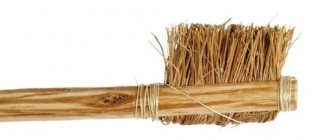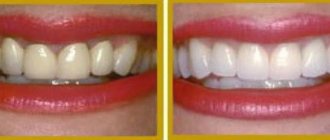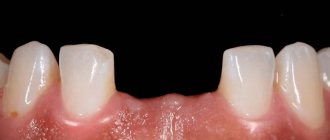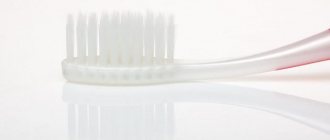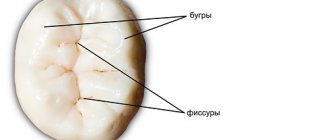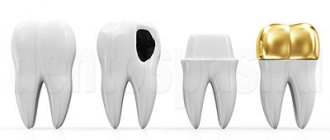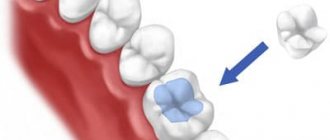If a tooth is destroyed by caries or as a result of injury, it must be restored, otherwise the tooth can be lost, and the absence of even one dental unit in a row is fraught with the most unpleasant consequences for health. For example, due to the absence of a tooth, an incorrect bite may develop, which leads to disruption of the correct process of chewing food and the development of various diseases of the digestive system.
If the tooth is slightly damaged, then most likely the doctor will use a regular, light-curing filling to restore it. But if the damage is significant, it would be more correct to use a stump tab.
Many people do not even know what kind of structure this is - a stump tab and for what purpose it is used by dentists. Meanwhile, the use of stump inlays makes it possible to successfully restore teeth that at first glance seem completely hopeless and must be removed.
In the article we will tell you in detail about what stump inlays are, what types of them exist, and why severely damaged teeth are best restored with inlays, and not with fillings and pins.
Advantages of installing a stump tab
- The design is prepared using impressions; it completely reproduces the existing space in the dental canal.
- The upper part of the tab is shaped like a tooth prepared for putting on a crown, which ensures proper distribution of the load, even if the tooth experiences strong pressure while chewing food.
- This design is installed over several visits to the doctor, but the result is a restored tooth, protected from destruction.
- The inlay is secured with special dental cement.
- The structure fits tightly to the tooth elements, preventing cracking.
- In a multichannel root, there can be several pin branches, depending on the number of roots.
Indications
Dental inlays are installed for a number of different tooth damages. Indications include:
- tooth damage by caries;
- hypoplasia of dental tissue;
- fluorosis;
- mechanical damage to the tooth as a result of trauma;
- wedge-shaped defect and other pathological phenomena.
Types of tabs
The manufacturing process is presented in two ways:
- Cast inlays - the process of casting the fixing pins and the main part occurs under pressure at high temperature.
- Collapsible - used if the tooth has more than two channels - in this case, removable pins are made.
It is impossible to remove such a tab after installation - a lifetime warranty is provided.
Depending on the material used, there are:
- Metal inlays for crowns are made from alloys of precious metals, an alloy of chromium and cobalt; these are durable and reliable products, but there is an aesthetic drawback;
- Ceramic inlays - made of zirconium dioxide and pressed ceramics, they are durable and highly aesthetic, the automated process of their production does not allow the formation of secondary caries, used for front teeth;
- Composite inlays are almost identical to fillings, so they are rarely used.
In what cases is the tab used?
The microprosthesis is attached to the prepared cavity and created in the laboratory using casts. This is a more reliable option compared to a universal filling. One of the most important advantages of this method is the possibility of restoration without depulping and covering with a crown.
The product can be used in many clinical cases, especially if the problem cannot be solved with a filling. The decision on the advisability of such an intervention should be made only together with an orthopedist; in the opposite situation, the risk of complications and repeated therapy increases.
Indications for installation
Patients should understand or, if necessary, ask the dentist about what an inlay is in orthopedics and in what cases its use is indicated. The design will not help in all situations.
You cannot do without mini-prostheses when:
- destruction of hard tissues by more than 30%;
- increased abrasion of molars, diagnosed by a dentist based on the results of diagnostic procedures;
- planning the placement of bridges (to restore units that will serve as support);
- a hole that is too large, when filling is impractical and ineffective.
Contraindications for installation
The question of what it means and how to make an inlay in a tooth disappears if such manipulations are contraindicated in a particular case. Restoration using miniprostheses is not used when:
- shallow depth of the carious cavity;
- damage to incisors and canines;
- too large a lesion and rapid spread of the pathological process;
- steep slopes;
- diagnosed bruxism (teeth grinding) of various etiologies; significant deepening of caries into the dentinal layer.
Also, experts do not recommend putting tabs on “eights”. This is a technically difficult task. If the bone tissue is significantly destroyed, it is better to resort to extraction of the unit, since it will still not be able to fully participate in the process of chewing food.
Is it possible to restore front teeth with inlays?
Such a prosthesis is not installed if there are problems with the incisors and canines. For this purpose, it is better to install lumineers or veneers.
If the crown is severely damaged, you can use a stump microprosthesis, hidden from prying eyes. Only chewing molars undergo restoration.
Further care and service life
The patient should adhere to standard hygiene rules, there are no special features. However, it is important to carry out all manipulations on a regular basis, to do this carefully and taking into account some nuances, in compliance with cleaning techniques. It is necessary to choose a high-quality paste, brush, floss (dental floss), and rinse aid.
The durability of a product directly depends on the material from which it was installed:
- metal will last up to 20 years;
- ceramic - up to 15;
- plastic - as a rule, no more than 5.
Possible complications
A dental inlay or filling on a tooth instead of part of a damaged crown is installed after preparation, which in its essence resembles a surgical intervention. Such actions of a doctor, due to his carelessness or the individual reaction of the body, sometimes cause:
- acute pulpitis;
- secondary caries;
- pain syndrome due to an infectious process.
Some people experience severe or moderate discomfort after treatment. Most often this is due to the inappropriate size of the prosthesis; in this situation, you need to visit the clinic so that the design is adjusted.
Before choosing a particular medical facility, it is important to pay attention to the qualifications of the staff and customer reviews. The better the work is done, the lower the risk of complications.
If the doctor makes a mistake, a cyst may develop due to excessive pressure of the microprosthesis on periodontal tissue. Also, during medical procedures, the possibility of damage to the root part cannot be ruled out.
The procedure for making tabs
There are two ways to obtain tabs.
Direct method:
- The tooth is treated and canals are prepared;
- Treat the cavity with Vaseline;
- The plastic is heated, poured into a syringe, squeezed into the formed cavity, forming an inlay;
- A pin is inserted into the canal;
- After the resulting structure has hardened, the finished model is removed from the cavity and transferred to dental technicians to produce a microprosthesis.
Indirect method:
- The doctor prepares the tooth, takes an impression and hands it over to the technicians;
- In the laboratory, a plaster model is cast, according to which a wax inlay is made;
- A metal model is made from the wax sample.
Contraindications
The use of tooth inlays is not indicated in the following cases:
- circular caries;
- medial-occlusal-distal cavities , combined with cervical caries or wedge-shaped defect;
- in the presence of systemic caries ;
- if the patient uses gastric juice or hydrochloric acid (with reduced acidity);
- presence of psychophysical disorders;
- childhood.
How to install a stump tab
- The nerve is removed and endodontic treatment of the canals is performed.
- The tooth is prepared;
- The canals are partially unsealed, giving them a cone shape;
- Measures are taken to create a microprosthesis directly or indirectly.
Installation procedure:
- The teeth are treated with a disinfectant composition (alcohol) and dried;
- The insert is degreased and coated with a cementitious composition;
- The solution is introduced into the channel cavity;
- The microprosthesis is inserted and pressed firmly on it so that high-quality fixation occurs;
- An impression is taken from the finished tooth to make a crown.
Which is better - fillings or inlays?
In general, modern microprosthetics is considered the most preferable option for correcting defects than filling. However, this method of restoration is not without its drawbacks and can also lead to complications of varying severity.
An important factor remains the right choice of dentist. No matter how modern and innovative the chosen method, in the hands of an inexperienced or irresponsible physician, the problem can worsen even further and lead to expensive and lengthy treatment.
Advantages and disadvantages of fillings
Advantages.
- Fast installation. Usually the product is installed in one session, less often (in the presence of serious violations) - in several.
- Multitasking. This means that a huge number of problems can be solved: temporarily protecting the prepared area, providing high-quality treatment, restoring a damaged unit.
- Durability. With proper care and proper installation, the accessory can last for many years, while the rows will look attractive and function fully.
- Versatility. You can get rid of minor or very serious defects.
- Low cost. All actions are performed by one specialist right on site.
Minuses.
- Material used. The mass mixes with liquids and shrinks after being distributed into the cavity. Voids, cracks, and chips may appear due to the resulting internal pressure.
- Preparation method. Since everything happens directly in the patient’s mouth, excess moisture negatively affects the properties of the filling composition.
- Composites are toxic and therefore contraindicated for children.
Advantages and disadvantages of inlays over fillings
Pros.
- Long service life, reliability. Do not lose their properties over time.
- Aesthetically attractive, keep their shape and do not shrink.
- There are no cracks or other unpleasant phenomena on the teeth.
- Thanks to the smooth surface, plaque does not accumulate.
- The anatomical shape of the molars does not change. The crown does not wear down or sag; as a result, the correct contour of the smile is created.
Minuses:
- high price compared to alternative restoration methods;
- complex manufacturing technique.
Advantages and disadvantages of the method
Positive aspects of the installation:
- The microprosthesis is durable and can withstand heavy loads;
- the tab fits perfectly, protecting the tooth from caries and pathogens;
- long period of operation;
- when the crown wears out, the structure does not need to be replaced;
- it is possible to choose the crown material;
- you can give the tooth the correct shape;
- bridge structures become easy to install;
- the method can be used to restore any teeth;
- The tooth is protected from future destruction.
Negative factors are:
- the need to visit the doctor twice;
- living tooth tissues undergo significant grinding;
- relatively high cost (more expensive than a pin).
The average cost of stump inlays in Moscow is from 2,000 rubles to 8,000 rubles.
Let's sum it up
When a carious lesion occurs, it is important to understand why dental inlays are needed, why they are better than a composite filling, and when they are contraindicated. It is important to understand that installing such structures is not always advisable and in some cases can lead to complications, which are much more difficult to get rid of than preparing a cavity and pouring filling material into it or installing a microprosthesis on cement.
Before starting treatment, you need to choose a good doctor who will prescribe diagnostic procedures, carefully study the research results and give recommendations during the recovery period. Although almost the entire process is automated, the participation of a professional orthopedist is the key to quality therapy without unpleasant consequences.
Specialists provide a full range of dental and orthopedic services, advise patients and offer optimal solutions to problems. Sign up for a consultation by phone or leave a request on our website, and we will contact you as soon as possible.
Cost of prosthetics in Moscow and other cities
How much does a zirconium inlay cost? Its price is 18-20 thousand rubles. Moreover, prices in the capital and other cities are approximately equivalent, because the basis is the cost of the material (which is purchased from the same manufacturers or suppliers).
1Zinovenko O.G., Shinkevich M.V., Sadovskaya I.V. Aesthetic prosthetics using zirconium dioxide, 2014.
Author: Sambuev B. S. (Thank you for your help in writing the article and the information provided)
What is known about the shortcomings
According to reviews from some patients, a zirconium inlay (restorative or stump) has only one drawback - its high cost. Another disadvantage is the time spent on prosthetics - it takes about 2 weeks to complete the treatment. Although, for example, CEREC technology allows you to make a restorative microprosthesis in 15-20 minutes - and it will be installed on the day you go to the clinic. However, such equipment is not available everywhere.
Read on the topic: what is CEREC technology - when does the dentist and patient need it, its pros and cons.
Another disadvantage is the pure white color of zirconium dioxide (several shades lighter than natural enamel) and its opacity. But dental technicians solve this problem by applying liquid ceramic, colored in the shade of enamel, to the upper part of the zirconium restorative microprosthesis. Or you can use alternative prosthetic options (more on them below).
Service life and care features
The service life of zirconium dioxide is very long - 15, 20 and even 25 years. Such long-term operation will depend both on the quality of preparation of the tooth for prosthetics and the accuracy of the fit of the orthopedic structure, as well as on compliance with the rules of wearing and caring for prostheses. What is needed for this? Do not forget about regular brushing of your teeth in the morning and evening, avoid hard and stretchy products (so that the denture does not come off). Ideally, you should also visit your podiatrist twice a year for a checkup.
Can a tooth get sick under an inlay and what to do if this happens?
If the tooth under the inlay hurts, you need to urgently contact a dental clinic, because pain under the installed microprosthesis can indicate the development of various kinds of complications. The main cause of complications after installing an inlay is medical errors that were made during the treatment process, and that is why it is so important to choose dentistry carefully! If, when treating a tooth, the doctor allows the pulp to overheat, an inflammatory process may begin, as a result of which the tooth under the tab will become sore. To eliminate pulpitis, you will have to remove the tooth inlay, receive appropriate treatment, and then restore the tooth again, possibly with a prosthetic crown or even implantation.
Inlays are often placed on teeth after caries treatment and it is extremely important that when working with a carious cavity, the dentist removes all destroyed tissue. If this is not done, secondary caries will begin under the tab, the treatment of which will again require removal of the tab.
Remember that if 5-7 days have passed after installing the inlay on the tooth, and your tooth hurts and the intensity of the pain is increasing, you need to urgently see a dentist, and not try to solve the problem yourself! If the infection gets into the root part of the tooth, it is not always possible to save the tooth and avoid its removal!
If the tooth does not hurt, but you have the feeling that it is bothering you - when eating, talking, trying to close your teeth - contact the clinic where you received the inlay to have its size corrected.
Care after prosthetics
Caring for your teeth after installing a core prosthesis differs little from normal oral hygiene. This should include brushing your teeth twice daily. In this case, it is better to use a brush with soft bristles.
After each eating session, it is advisable to rinse your mouth with warm water, herbal infusions (chamomile, sage) or special ready-made mouth rinses.
To clean the interdental spaces, use floss or a brush.
It is advisable to visit a dentist every six months.
Complications and errors
Errors in the manufacture of core inlays are divided into two groups: those associated with the work of the dentist and the actions of the dental technician.
Clinical:
- unsealing of the canal to an unsatisfactory amount;
- root perforation during turning;
- giving an inadequate shape to the channel, which can lead to de-cementing of the structure;
- errors when taking impressions.
Laboratory:
- poor-quality casting when using the casting method;
- non-compliance with processing standards during the pressing method;
- violation of the firing regime when applying ceramic layers.
Quality criteria for core restoration: high aesthetic level, reliable fixation, long service life, uniform distribution of pressure when pressed.
General information about designs
Zirconium dioxide inlay - what is it? You need to understand that inlays in dentistry belong to the field of prosthetics, or more precisely, microprosthetics. That is, these are small-sized prostheses, which come in 2 types:
- restorative (or coronal): independently restore the integrity of the tooth,
- stump (or pin): serve as a support for another prosthesis - a crown, bridge, removable orthopedic structure.
Both restorative and pin inlays are made from zirconium oxide1 - we will describe below what each of these zirconium inlays is and what it looks like. It is worth noting that zirconium dioxide is a very strong material in compression and bending (more than 1400 MPa), in this it can even be compared with metal alloys. However, zirconium dioxide is more often called ceramics - more precisely, metal-free ceramics, since purely externally the material is white, like your own teeth.
Zirconium dioxide crown on an implant for the whole 70,000 rubles.
OSSTEM implant (South Korea), individual zirconium abutment, gum former, impression taking.
Creation of a Prettau zirconium crown using 3D modeling technology. Consultation with 2 doctors: an orthopedist and an implantologist for free! Call now or request a call
Opening hours: 24 hours a day - seven days a week
Minuses
Like any other type of prosthesis, the stump tab has some disadvantages in technology and manufacturing time:
- High cost and longer production time (requires several visits to the orthodontist).
- Duration of treatment (preparatory stage for installing the “inlay + crown” complex after the second visit to a specialist).
- Cutting down a significant amount of bone and tissue for maximum docking during installation.
Installation process
The stump tab is installed sequentially in several stages. Compliance with technology guarantees maximum efficiency and a long operational period. The installation can be carried out in order for the inlay to function both independently and under the crown. The selection of the type and shape of the product is carried out individually in each case.
After manufacturing, the installation procedure is carried out. The step-by-step process in the case of installing a structure on one tooth is as follows:
- Examination by an orthopedist.
- X-ray examination.
- Complex treatment. If the tooth is severely damaged, first it is treated according to the classical scheme - filling the canals and installing a filling. Then they clean and form a cavity for the structure.
- Taking impressions, which is carried out several times. Initially, an impression of the filled and adjacent teeth is made, and then an impression of the inner surface is made using wax.
- Installation of a temporary tab. This is necessary because the production of the main tab takes 7-14 days.
- Making a crown. It is made so that it fits as best as possible to the adjacent teeth and the opposite jaw.
- For teeth with several roots, a folding product is created and then installed in a cavity with a special hole for an additional pin. The finished structure is secured with a special solution. As a result of the manipulation, a monolithic insert is obtained.
- Fixation of the crown. It is carried out directly to the tab.
The orthopedist can adjust the listed stages taking into account the individual characteristics of the patient. During the installation procedure, local anesthesia is used.
Improper installation of dental inlays under crowns can cause various complications. It becomes mobile, the pressure during chewing is distributed unevenly, and there is an increased load on the soft tissues. All this leads to breakage and loss of the product.
Complications usually arise due to improper filling of the canal. If it is poorly cleaned or not completely sealed, then chronic inflammation occurs. Acute pain appears, to eliminate which you have to treat the tooth by removing the prosthesis. Therefore, for prosthetics you need to choose a qualified dentist who guarantees the quality of his work.




